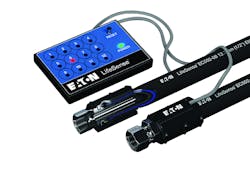Smart Hydraulic Hose Protects Golf Greens
Golf courses use a wide variety of mobile equipment for maintaining fairways, greens, and other areas. So if equipment failure causes oil to leak onto public areas, costs to clean up and repair the affected area can be substantial. Plus, well-known country clubs, such as The Greenbrier, White Sulphur Springs, W. Va., have an impeccable reputation to maintain, which makes leakage prevention even more important.
Naturally, regular inspection of hose would be a regular part of the operating routing for this mowers, rollers, and other hydraulically powered equipment. The Greenbrier has four golf courses, and thousands of acres of immaculately groomed landscape, so all the equipment involved in caring for all this real estate holds significant potential for leaks if its not carefully maintained.
The Challenge
Staff at Greenbier uses mowers and rollers to maintain its immaculate greens early in the morning while it is still dark and the bent grass turf is covered in dew. The low-light conditions of the early morning make it difficult for equipment operators to notice if a hydraulic hose failure occurs, leaving the course open to potential damage of its most prized real estate.
The equipment contains multiple hydraulic hoses in hard-to-see places. Yet, if one of the hoses fails unexpectedly during a course’s turf care routine and goes unnoticed, it can disrupt the operation and create significant costs—in terms of both dollars and reputation.
The resulting fluid spill can cause extensive turf damage, including the possibility of a course having to replace a green and close for repair—a costly consequence. To avoid unexpected hose failure, many superintendents frequently replace hydraulic hoses on equipment before it is necessary.
As part of The Greenbrier’s preventive maintenance program, staff conducted a comprehensive monthly review of its turf care equipment, which included hydraulic hose inspection. They visually checked individual hoses for signs of failure. When they identified a potential problem with a hose, it was replaced. Even with this regimen, staff at The Greenbrier was not completely satisfied it was catching every problematic hose, so it looked to Eaton Hydraulics, Eden Prairie, Minn., for a solution.
Taking Action
Eaton recommended its LifeSense hydraulic hose condition monitoring system for the resort’s greens rollers. The LifeSense system monitors hydraulic hose conditions and detects failure-related events to provide advance notification that a hose is approaching the end of its useful life.
During the early winter of 2013, The Greenbrier staff replaced about six ½-in. hoses on three greens rollers with LifeSense hose. Deciding which hoses would be replaced was based on hydraulic pressure, amount of motion, potential abrasion, and similar factors. Also, because it is difficult to detect wear of hose installed in inaccessible areas, location of each hose assembly within the machine was also considered.
Each hose contains a sensor that continuously monitors hose conditions and generates a electrical signals. These signals then transmit to a diagnostic unit that interprets the feedback. If the system identifies a hose that has been compromised, an alert is generated to warn personnel.
“This is one of those solutions that you hope you never have to use, much like an insurance policy,” said Kelly Shumate, director of golf course maintenance at The Greenbrier. “LifeSense provides a total sense of security that even with our strict and regular maintenance on the rollers, if we miss something, it will alert us before we have a big problem on our hands.”
Results
The Greenbrier’s course managers have been quite satisfied with Eaton’s LifeSense system, which reinforces its sound maintenance practices and gives them enhanced confidence that greens will remain pristine just as its players have come to expect. In fact, during testing, the LifeSense system signaled a problem with one of the hoses after three months. Sure enough, an inspection revealed that the hose has suffered from premature abrasive wear. When the new hose assembly was installed, it was rerouted to prevent future abrasive wear.
The Greenbrier chose to use Eaton’s hard-wired LifeSense system. Eaton also offers a wireless version, which can even send alerts to smart phones. The simple hard-wired system has as red light that blinks if a hose sensor connector becomes loose, and the light illuminates constantly if a failure is detected, thereby minimizing false alarms.
“We are always working to provide innovative solutions that will push the boundaries of what is possible and technology that meets customer needs head on. LifeSense is a game changer for golf course maintenance,” said Kelly Moore-Floyd, Eaton product manager. “With LifeSense, course superintendents gain peace of mind knowing their hydraulic hoses are constantly monitored, providing assurance that they are taking steps to avoid turf damage and unexpected and expensive repairs.”
For more information, call Eaton’s Hydraulics Group at (952) 937-9800; or click here.


